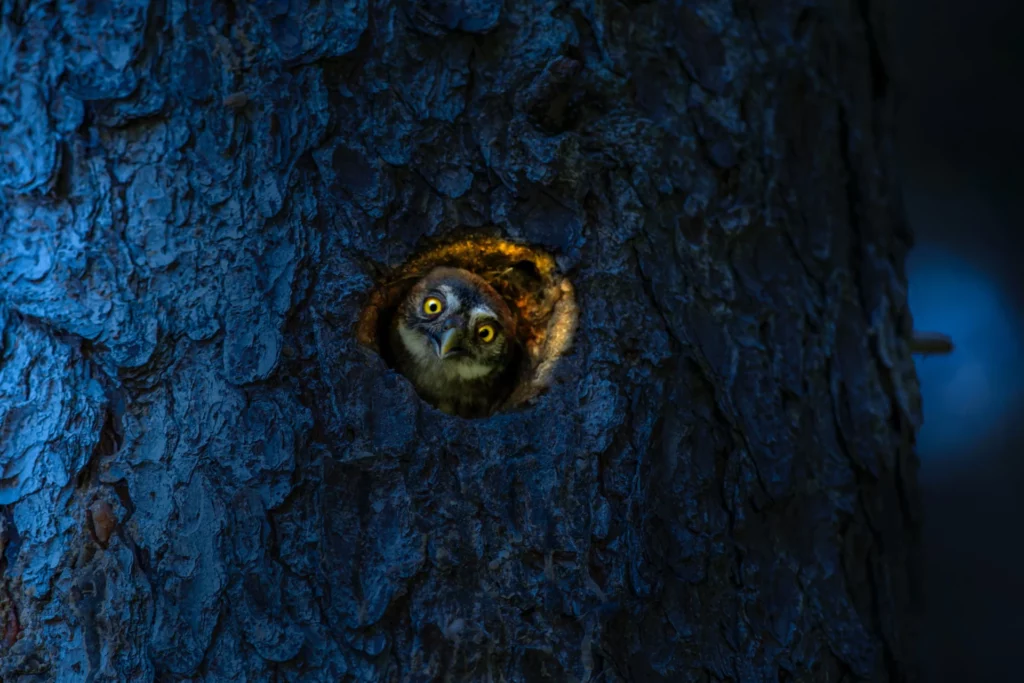Owls are one of those animals that have a certain aura about them. They look very mysterious and wise. They are undoubtedly magical in many ways. No wonder why they were tasked with the important job of delivering parcels and posts in Harry Potter.
As cool as it would be, owls do not deliver parcels in the real world. But if they would, they would be good at it since they have fantastic eyesight.
As owls are nocturnal creatures, their vision is made for darkness. However, still, there’s a lot to know about whether can owls see in the dark. Let’s check it out!
Can Owls See In the Dark?
Owls have exceptional night vision with large front-facing eyes that absorb much light. This allows them to see clearly in the dark. Most owls are nocturnal. This means good night vision is essential.
They can see much better than us at night – 10 to 100 times better than humans, to be exact. Their eyes are very big too. The pupils become larger at night to absorb as much light as possible.
Like humans, their eyes are also at the front of their heads. And owls are one of the few birds with eyes like that. The eyes at the front of their heads help to focus on what is in front of them, for example, prey.
However, there is a big difference between our eyes and an owl’s eyes. Owls do not have eyeballs.
Their eyes are more like tubes. And they cannot move them like we can when we want to look around. Which means owl eyes are held in place.
But nature came to the rescue here. Owls can turn their heads 270 degrees left and right and 90 degrees up and down, which helps them see what is around them.
How Do Owls See In The Dark?

An owl’s excellent night-time vision is thanks to their ability to dilate their pupils considerably. This allows them to take in a ton of light. Moreover, they have 30 times more cone-shaped photoreceptor cells, which allow them to see clearly in the dark.
An owl needs to eat. And it just so happens that most of its prey are active during the night. Therefore, most owls are nocturnal as well. Therefore, good night vision is crucial for their survival. Here is what you need to know about how an owl’s eye work:
- Their large pupils can dilate wide, which allows tons of light in
- Owls have front-facing eyes like us, and this helps them focus on their prey.
- Two kinds of photoreceptor cells take in light and turn it into electrical signals. The brain then turns these electrical signals to form an image.
The lens and cornea in an owl’s eyes guide the light into the retina at the back of their eyes. The retina has photoreceptor cells, and owls have two kinds of photoreceptors:
- Cone-shaped photoreceptor cells
- Rod-shaped photoreceptor cells
The cone-shaped photoreceptor cells allow the owls to understand where things are in space relative to each other. They also help with seeing colors. On the other hand, rod-shaped cells help with low-light vision. These cells process black-and-white images.
Owls have 30 times more rod-shaped cells closely packed together than cone-shaped ones, allowing them to see very well in the dark. But it also means that they are not that good at seeing color.
Do Owls See Better In The Dark?
Owls do see better in the dark than in the daytime. But that does not mean they are blind during the day. It is a common misconception that owls cannot see during the day.
Remember how owls can make their eyes bigger to see better at night? They can also make the pupils in their eyes small. When the pupils are smaller, it blocks some of the bright sunlight.
Some owls will also close their eyes slightly to block even more light. This is why when you look at an owl during the day, it looks like they are half asleep.
But they are fully aware. It is very interesting to see how they have adapted to their situation.
How Far Can Owls See At Night?
Owls are far-sighted. Meaning they cannot see things that are close to them very well. At night owls can see as far as a mile.
They can even spot prey at that distance as well. Some owls can see a small mouse moving and running around as far as half a mile into the distance. Owls can spot larger prey like rabbits, even if they are over a mile away.
And since owls cannot move their eyes, they move their whole head to focus on a particular thing. Besides their crazy good eyesight, owls have also developed very good hearing.
When hunting snakes (yes, they sometimes hunt and eat snakes), an owl relies on its eyes and hearing to spot its prey.
Not all owls have the same sharp eyesight, though, For example, a snowy owl’s eyes are not as sensitive as other owl species. They rely more on their hearing since their prey often hides under snow.
The most commonly seen barn owls actually have relatively smaller eyes. Despite their relative differences, owls have very good eyesight compared to other birds and animals.
Conclusion
So, can owls see in the dark? Yes, they can, and they can do so very well. Their special eyes are perfectly adapted to help them see clearly in the dark.
Additionally, since their eyes are uniquely shaped, owls have also developed the ability to turn their heads very far.

